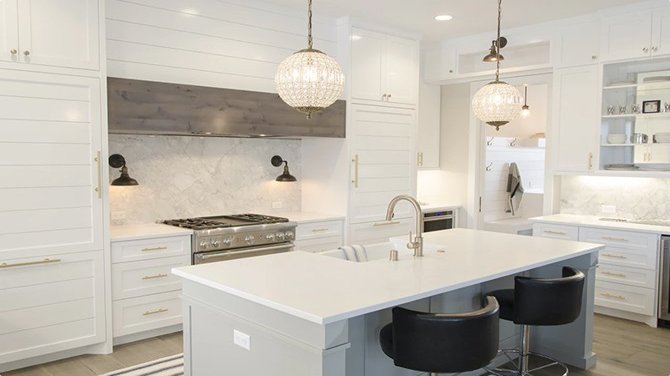
Introduction
Bathroom design is about more than just functionality — it is also an opportunity to express your personal style. The vanity and cabinets you choose set the tone for the entire space, affecting both its look and usability. Whether you are going for a sleek modern feel, a cozy farmhouse vibe, or a timeless classic design, the right selection can transform your bathroom. If you are planning a remodel or working with a Bathroom vanities & cabinets installation in Glendora, CA, understanding how to match your style with the right features is key.
In this guide, we will explore the factors to consider when selecting bathroom vanities and cabinets so your design reflects your personality while meeting your practical needs.
Before diving into the details, ask yourself this:
Do you want your bathroom to be a relaxing retreat, a bold statement space, or a functional everyday zone?
Your vision will guide your decisions on colors, materials, and design details.
Step 1: Identify Your Style Preference
Before selecting vanities and cabinets, determine the overall style you want for your bathroom.
Popular styles include:
- Modern: Clean lines, minimal hardware, and neutral or bold monochrome colors.
- Traditional: Detailed molding, warm wood tones, and elegant fixtures.
- Farmhouse: Shaker-style doors, rustic finishes, and open shelving.
- Coastal: Light colors, natural textures, and airy designs.
Having a style in mind will narrow your choices and ensure a cohesive look.
Step 2: Consider the Size and Layout of Your Bathroom
The dimensions of your bathroom directly influence the type of vanity and cabinets you can install.
For small bathrooms:
- Opt for wall-mounted or floating vanities to create an illusion of space.
- Choose compact cabinetry with efficient storage solutions.
For large bathrooms:
- Consider double vanities for added convenience.
- Incorporate tall cabinets or built-in shelving for extra storage.
Step 3: Choose the Right Material
Bathroom cabinets and vanities must withstand humidity, water splashes, and temperature changes.
Best materials include:
- Solid Wood: Durable and timeless, but requires sealing to resist moisture.
- Plywood: Strong, stable, and more resistant to warping than solid wood.
- MDF (Medium-Density Fiberboard): Smooth finish, great for painted surfaces, and budget-friendly.
- Laminate: Easy to clean and available in many finishes.
Always choose materials designed for bathroom use to ensure longevity.
Step 4: Select the Ideal Finish and Color
The finish you choose affects the mood and style of your bathroom.
Popular choices:
- Natural Wood Stain: Warm, organic feel for rustic or traditional spaces.
- Matte Paint: Soft, modern look with minimal glare.
- Glossy Finish: Sleek and reflective, ideal for modern bathrooms.
- Two-Tone Designs: Adds depth by combining two colors on upper and lower cabinets.
Choose colors that complement your tiles, countertops, and fixtures.
Step 5: Think About Storage Needs
Your vanity and cabinets should provide enough storage to keep your bathroom clutter-free.
Storage solutions:
- Drawers with organizers for toiletries.
- Shelving for towels and decorative items.
- Pull-out baskets for easy access to cleaning supplies.
Assess your daily routine to decide how much and what type of storage you need.
Step 6: Choose the Right Countertop Material
The countertop is both a functional and design element of your vanity.
Options include:
- Quartz: Durable, low-maintenance, and available in various colors.
- Granite: Natural beauty with unique patterns.
- Marble: Elegant and timeless but requires more care.
- Solid Surface: Seamless appearance and easy to clean.
Step 7: Match the Hardware to Your Style
Handles, knobs, and pulls can enhance your chosen design.
Suggestions:
- Modern: Sleek, straight bar pulls in matte black or brushed nickel.
- Traditional: Ornate knobs with antique brass finishes.
- Farmhouse: Cup pulls and rustic iron handles.
Consistency in hardware finish creates a polished look.
Step 8: Coordinate with Bathroom Fixtures
Your vanity and cabinets should complement your sink, faucet, mirror, and lighting.
Tips:
- Match faucet and cabinet hardware finishes.
- Use mirrors that reflect your chosen style — round mirrors for modern, framed mirrors for traditional.
- Choose lighting that highlights your vanity area.
Step 9: Balance Functionality with Aesthetics
While design is important, your vanity and cabinets must meet your functional needs.
Ask yourself:
- Is the height comfortable?
- Are the drawers deep enough?
- Is there room for plumbing under the sink without wasting storage space?
Step 10: Test Samples Before Deciding
If possible, order material and color samples to see how they look under your bathroom lighting. This helps avoid costly mistakes and ensures your choices work together harmoniously.
Combining Styles for a Unique Look
You do not have to stick to one style — mixing elements can create a unique, personalized design.
For example:
- Pairing a modern floating vanity with rustic wood cabinets.
- Combining matte black hardware with classic white cabinetry.
- Adding coastal accents like rope handles to a traditional setup.
Budget-Friendly Tips
- Refinish existing cabinets instead of replacing them.
- Change only the cabinet doors for a fresh look.
- Use open shelving to save on material costs.
- Invest in quality hardware for an instant upgrade.
Conclusion
Choosing the right bathroom vanities and cabinets is about blending personal style with practical needs. From selecting durable materials and finishes to ensuring optimal storage and design harmony, every detail contributes to a bathroom you will enjoy for years. Whether you are renovating a master bath, guest bathroom, or powder room, taking the time to plan your design will make all the difference. If you are working with a Bathroom vanities & cabinets installation in Glendora, CA, these tips will help you create a space that is stylish, functional, and perfectly suited to your taste.


